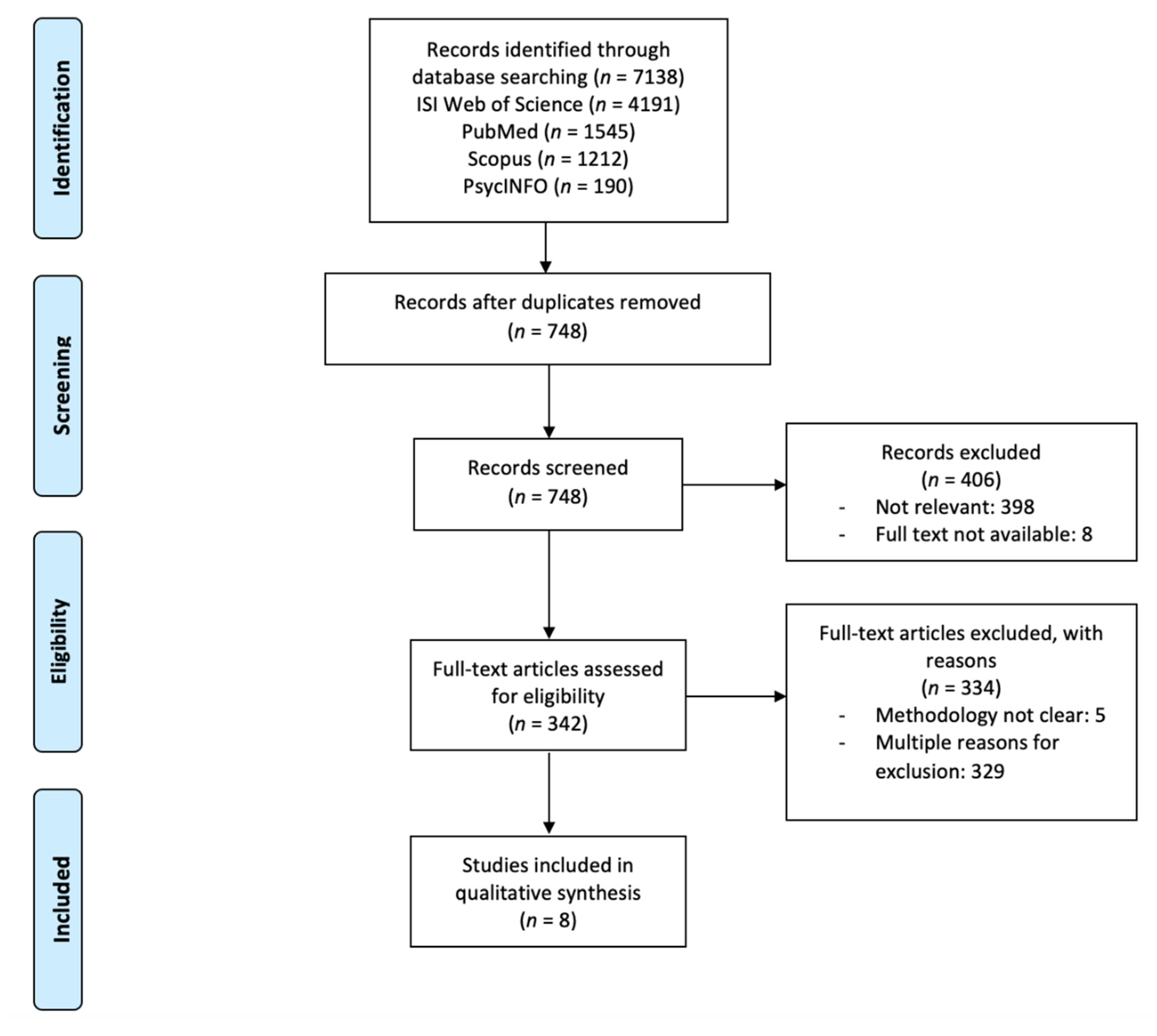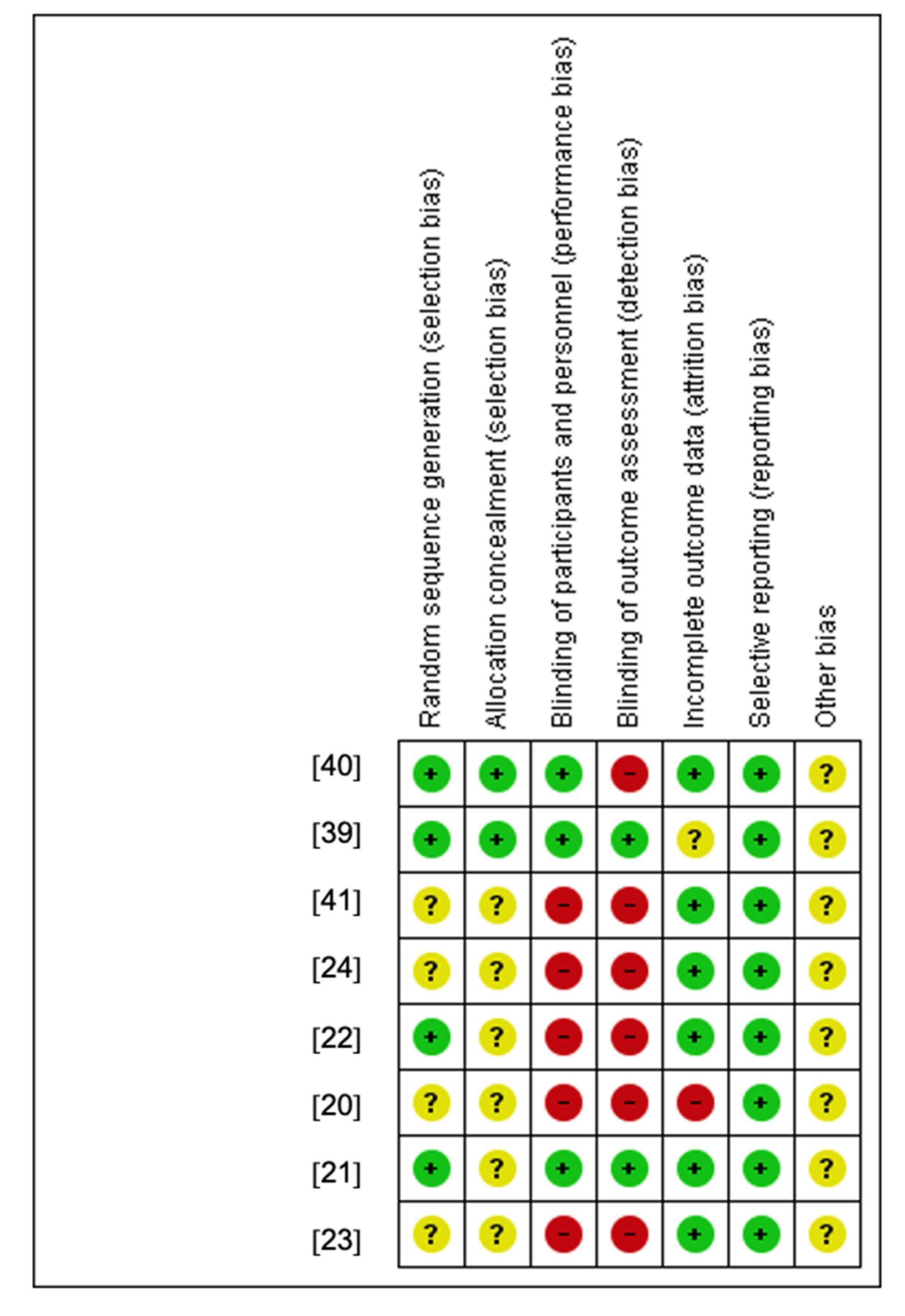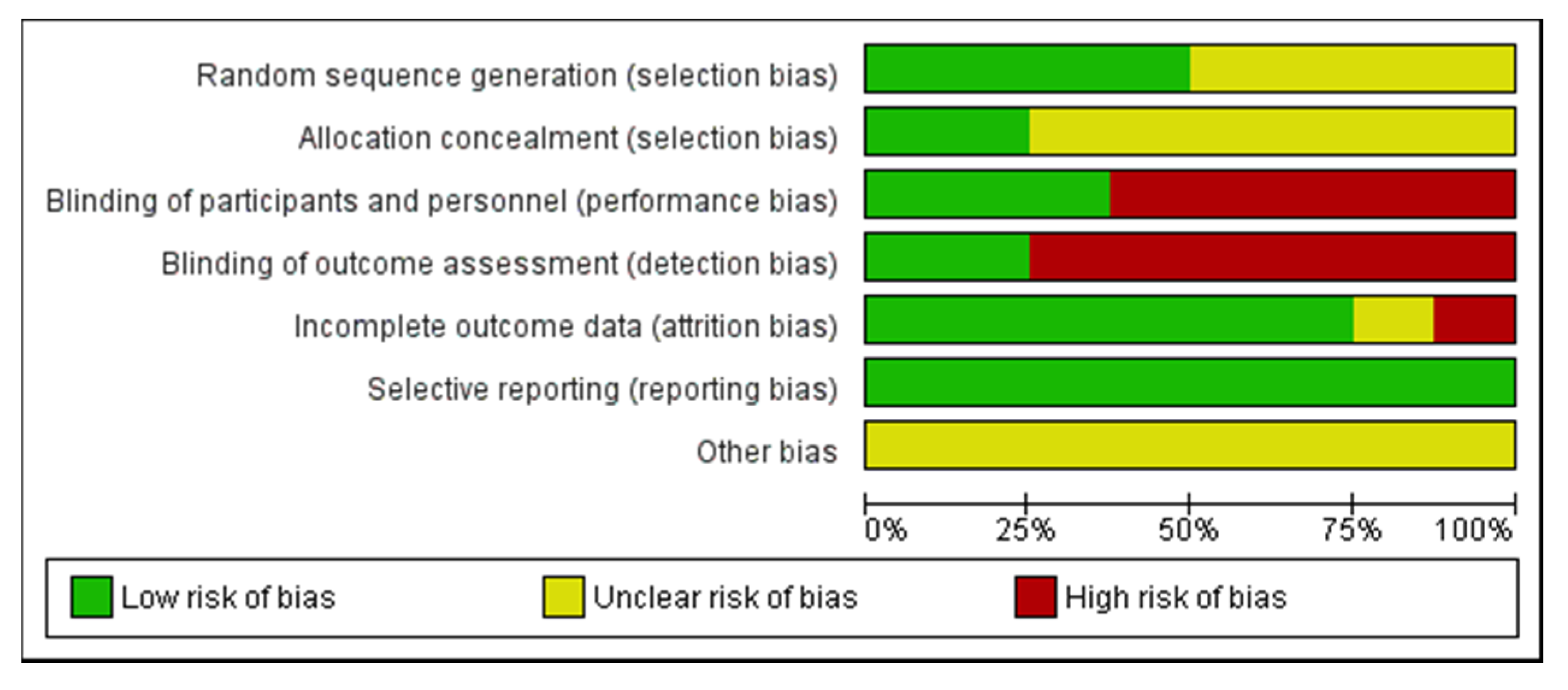High-Intensity Interval Training upon Cognitive and Psychological Outcomes in Youth: A Systematic Review
Abstract
1. Introduction
2. Materials and Methods
2.1. Search Strategy
2.2. Study Selection and Eligibility Criteria
2.3. Data Extraction and Synthesis
2.4. Data Analysis
Assessment Risk of Bias
2.5. Statistical Analysis
3. Results
3.1. Description of the Studies Reviewed
3.2. Risk of Bias in the Included Articles
3.3. HIIT in Children and Adolescents Cognitive Performance
3.4. HIIT in Children and Adolescents Psychological Outcomes
3.5. HIIT in Cognitive Performance and Psychological Outcomes
4. Discussion
5. Conclusions
Supplementary Materials
Author Contributions
Funding
Institutional Review Board Statement
Informed Consent Statement
Data Availability Statement
Conflicts of Interest
References
- Janssen, I.; LeBlanc, A.G. Systematic review of the health benefits of physical activity and fitness in school-aged children and youth. Int. J. Behav. Nutr. Phys. Act. 2010, 7, 40. [Google Scholar] [CrossRef]
- Lees, C.; Hopkins, J. Effect of Aerobic Exercise on Cognition, Academic Achievement, and Psychosocial Function in Children: A Systematic Review of Randomized Control Trials. Prev. Chronic Dis. 2013, 10, 130010. [Google Scholar] [CrossRef]
- Piercy, K.L.; Troiano, R.P.; Ballard, R.M.; Carlson, S.A.; Fulton, J.E.; Galuska, D.A.; George, S.M.; Olson, R.D. The Physical Activity Guidelines for Americans. JAMA 2018, 320, 2020. [Google Scholar] [CrossRef]
- de Greeff, J.W.; Bosker, R.J.; Oosterlaan, J.; Visscher, C.; Hartman, E. Effects of physical activity on executive functions, attention and academic performance in preadolescent children: A meta-analysis. J. Sci. Med. Sport 2018, 21, 501–507. [Google Scholar] [CrossRef]
- Tomporowski, P.D.; Lambourne, K.; Okumura, M.S. Physical activity interventions and children’s mental function: An introduction and overview. Prev. Med. 2011, 52, S3–S9. [Google Scholar] [CrossRef]
- Hillman, C.H.; Erickson, K.I.; Kramer, A.F. Be smart, exercise your heart: Exercise effects on brain and cognition. Nat. Rev. Neurosci. 2008, 9, 58–65. [Google Scholar] [CrossRef]
- Keeley, T.J.H.; Fox, K.R. The impact of physical activity and fitness on academic achievement and cognitive performance in children. Int. Rev. Sport Exerc. Psychol. 2009, 2, 198–214. [Google Scholar] [CrossRef]
- Guthold, R.; Stevens, G.A.; Riley, L.M.; Bull, F.C. Global trends in insufficient physical activity among adolescents: A pooled analysis of 298 population-based surveys with 1·6 million participants. Lancet Child Adolesc. Health 2020, 4, 23–35. [Google Scholar] [CrossRef]
- Stein, R.; Börjesson, M. Physical Inactivity in Brazil and Sweden—Different Countries, Similar Problem. Arq. Bras. Cardiol. 2019. [Google Scholar] [CrossRef]
- Bai, Y.; Saint-Maurice, P.F.; Welk, G.J.; Allums-Featherston, K.; Candelaria, N.; Anderson, K. Prevalence of Youth Fitness in the United States: Baseline Results from the NFL PLAY 60 FITNESSGRAM Partnership Project. J. Pediatr. 2015, 167, 662–668. [Google Scholar] [CrossRef]
- Heradstveit, O.; Haugland, S.; Hysing, M.; Stormark, K.M.; Sivertsen, B.; Bøe, T. Physical inactivity, non-participation in sports and socioeconomic status: A large population-based study among Norwegian adolescents. BMC Public Health 2020, 20, 1010. [Google Scholar] [CrossRef]
- Sancassiani, F.; Machado, S.; Preti, A. Physical Activity, Exercise and Sport Programs as Effective Therapeutic Tools in Psychosocial Rehabilitation. Clin. Pract. Epidemiol. Ment. Health 2018, 14, 6–10. [Google Scholar] [CrossRef]
- Gibala, M.J.; Gillen, J.B.; Percival, M.E. Physiological and Health-Related Adaptations to Low-Volume Interval Training: Influences of Nutrition and Sex. Sports Med. 2014, 44, 127–137. [Google Scholar] [CrossRef]
- Cao, M.; Quan, M.; Zhuang, J. Effect of High-Intensity Interval Training versus Moderate-Intensity Continuous Training on Cardiorespiratory Fitness in Children and Adolescents: A Meta-Analysis. Int. J. Environ. Res. Public Health 2019, 16, 1533. [Google Scholar] [CrossRef]
- Buchheit, M.; Laursen, P.B. High-Intensity Interval Training, Solutions to the Programming Puzzle. Sports Med. 2013, 43, 313–338. [Google Scholar] [CrossRef]
- Corte de Araujo, A.C.; Roschel, H.; Picanço, A.R.; do Prado, D.M.L.; Villares, S.M.F.; de Sá Pinto, A.L.; Gualano, B. Similar Health Benefits of Endurance and High-Intensity Interval Training in Obese Children. PLoS ONE 2012, 7, e42747. [Google Scholar] [CrossRef]
- Meßler, C.F.; Holmberg, H.-C.; Sperlich, B. Multimodal Therapy Involving High-Intensity Interval Training Improves the Physical Fitness, Motor Skills, Social Behavior, and Quality of Life of Boys with ADHD: A Randomized Controlled Study. J. Atten. Disord. 2018, 22, 806–812. [Google Scholar] [CrossRef]
- Buchan, D.S.; Ollis, S.; Young, J.D.; Cooper, S.-M.; Shield, J.P.; Baker, J.S. High intensity interval running enhances measures of physical fitness but not metabolic measures of cardiovascular disease risk in healthy adolescents. BMC Public Health 2013, 13, 498. [Google Scholar] [CrossRef]
- Crisp, N.A.; Fournier, P.A.; Licari, M.K.; Braham, R.; Guelfi, K.J. Adding sprints to continuous exercise at the intensity that maximises fat oxidation: Implications for acute energy balance and enjoyment. Metabolism 2012, 61, 1280–1288. [Google Scholar] [CrossRef]
- Mayr, H.L.; Cohen, F.; Isenring, E.; Soenen, S.; Marshall, S. Multidisciplinary lifestyle intervention in children and adolescents—Results of the project GRIT (Growth, Resilience, Insights, Thrive) pilot study. BMC Pediatr. 2020, 20, 174. [Google Scholar] [CrossRef]
- Mezcua-Hidalgo, A.; Ruiz-Ariza, A.; Suárez-Manzano, S.; Martínez-López, E.J. 48-Hour Effects of Monitored Cooperative High-Intensity Interval Training on Adolescent Cognitive Functioning. Percept. Mot. Skills 2019, 126, 202–222. [Google Scholar] [CrossRef]
- Martínez-López, E.J.; Torre-Cruz, M.J.; Suárez-Manzano, S.; Ruiz-Ariza, A. 24 sessions of monitored cooperative high-intensity interval training improves attention-concentration and mathematical calculation in secondary school. J. Phys. Educ. Sport 2018, 18, 1578–1582. [Google Scholar] [CrossRef]
- Tottori, N.; Morita, N.; Ueta, K.; Fujita, S. Effects of High Intensity Interval Training on Executive Function in Children Aged 8–12 Years. Int. J. Environ. Res. Public Health 2019, 16, 4127. [Google Scholar] [CrossRef]
- Malik, A.A.; Williams, C.A.; Weston, K.L.; Barker, A.R. Influence of personality and self-efficacy on perceptual responses during high-intensity interval exercise in adolescents. J. Appl. Sport Psychol. 2020, 1–19. [Google Scholar] [CrossRef]
- Ruiz-Ariza, A.; Grao-Cruces, A.; de Loureiro, N.E.M.; Martínez-López, E.J. Influence of physical fitness on cognitive and academic performance in adolescents: A systematic review from 2005–2015. Int. Rev. Sport Exerc. Psychol. 2017, 10, 108–133. [Google Scholar] [CrossRef]
- Thomas, J.; Thirlaway, K.; Bowes, N.; Meyers, R. Effects of combining physical activity with psychotherapy on mental health and well-being: A systematic review. J. Affect. Disord. 2020, 265, 475–485. [Google Scholar] [CrossRef]
- Brett, B.L.; Huber, D.L.; Wild, A.; Nelson, L.D.; McCrea, M.A. Age of First Exposure to American Football and Behavioral, Cognitive, Psychological, and Physical Outcomes in High School and Collegiate Football Players. Sports Health A Multidiscip. Approach 2019, 11, 332–342. [Google Scholar] [CrossRef]
- Gale, C.R.; Hatch, S.L.; Batty, G.D.; Deary, I.J. Intelligence in childhood and risk of psychological distress in adulthood: The 1958 National Child Development Survey and the 1970 British Cohort Study. Intelligence 2009, 37, 592–599. [Google Scholar] [CrossRef]
- Jaycox, L.H.; Stein, B.D.; Paddock, S.; Miles, J.N.V.; Chandra, A.; Meredith, L.S.; Tanielian, T.; Hickey, S.; Burnam, M.A. Impact of Teen Depression on Academic, Social, and Physical Functioning. Pediatrics 2009, 124, e596–e605. [Google Scholar] [CrossRef]
- Gist, N.H.; Fedewa, M.V.; Dishman, R.K.; Cureton, K.J. Sprint Interval Training Effects on Aerobic Capacity: A Systematic Review and Meta-Analysis. Sports Med. 2014, 44, 269–279. [Google Scholar] [CrossRef]
- Logan, G.R.M.; Harris, N.; Duncan, S.; Schofield, G. A Review of Adolescent High-Intensity Interval Training. Sports Med. 2014, 44, 1071–1085. [Google Scholar] [CrossRef]
- Tomporowski, P.D.; Davis, C.L.; Miller, P.H.; Naglieri, J.A. Exercise and Children’s Intelligence, Cognition, and Academic Achievement. Educ. Psychol. Rev. 2008, 20, 111–131. [Google Scholar] [CrossRef]
- Shamseer, L.; Moher, D.; Clarke, M.; Ghersi, D.; Liberati, A.; Petticrew, M.; Shekelle, P.; Stewart, L.A. Preferred reporting items for systematic review and meta-analysis protocols (PRISMA-P) 2015: Elaboration and explanation. BMJ 2015, 349, g7647. [Google Scholar] [CrossRef]
- Moher, D.; Liberati, A.; Tetzlaff, J.; Altman, D.G. Preferred Reporting Items for Systematic Reviews and Meta-Analyses: The PRISMA Statement. PLoS Med. 2009, 6, e1000097. [Google Scholar] [CrossRef]
- Methley, A.M.; Campbell, S.; Chew-Graham, C.; McNally, R.; Cheraghi-Sohi, S. PICO, PICOS and SPIDER: A comparison study of specificity and sensitivity in three search tools for qualitative systematic reviews. BMC Health Serv. Res. 2014, 14, 579. [Google Scholar] [CrossRef]
- Cohen, J. Statistical Power Analysis for the Behavioural Sciences, 2nd ed.; Routledge: New York, NY, USA, 1988; ISBN 9780203771587. [Google Scholar]
- Higgins, J.P.; Green, S. Cochrane Handbook for Systematic Reviews of Interventions, Version 5.1.0; The Cochrane Collaboration, Ed.; The Cochrane Collaboration: London, UK, 2011. [Google Scholar]
- Conboy, J.E. Algumas medidas típicas univariadas da magnitude do efeito. Anal. Psicol. 2003, 21, 145–158. [Google Scholar]
- Costigan, S.A.; Eather, N.; Plotnikoff, R.C.; Hillman, C.H.; Lubans, D.R. High-Intensity Interval Training for Cognitive and Mental Health in Adolescents. Med. Sci. Sports Exerc. 2016, 48, 1985–1993. [Google Scholar] [CrossRef]
- Ardoy, D.N.; Fernández-Rodríguez, J.M.; Jiménez-Pavón, D.; Castillo, R.; Ruiz, J.R.; Ortega, F.B. A Physical Education trial improves adolescents’ cognitive performance and academic achievement: The EDUFIT study. Scand. J. Med. Sci. Sports 2014, 24, e52–e61. [Google Scholar] [CrossRef]
- Malik, A.A.; Williams, C.A.; Bond, B.; Weston, K.L.; Barker, A.R. Acute cardiorespiratory, perceptual and enjoyment responses to high-intensity interval exercise in adolescents. Eur. J. Sport Sci. 2017, 17, 1335–1342. [Google Scholar] [CrossRef]
- De Morton, N.A. The PEDro scale is a valid measure of the methodological quality of clinical trials: A demographic study. Aust. J. Physiother. 2009, 55, 129–133. [Google Scholar] [CrossRef]
- Lubans, D.; Richards, J.; Hillman, C.; Faulkner, G.; Beauchamp, M.; Nilsson, M.; Kelly, P.; Smith, J.; Raine, L.; Biddle, S. Physical Activity for Cognitive and Mental Health in Youth: A Systematic Review of Mechanisms. Pediatrics 2016, 138, e20161642. [Google Scholar] [CrossRef]
- Hillman, C.H.; Pontifex, M.B.; Castelli, D.M.; Khan, N.A.; Raine, L.B.; Scudder, M.R.; Drollette, E.S.; Moore, R.D.; Wu, C.-T.; Kamijo, K. Effects of the FITKids Randomized Controlled Trial on Executive Control and Brain Function. Pediatrics 2014, 134, e1063–e1071. [Google Scholar] [CrossRef]
- Bidzan-Bluma, I.; Lipowska, M. Physical Activity and Cognitive Functioning of Children: A Systematic Review. Int. J. Environ. Res. Public Health 2018, 15, 800. [Google Scholar] [CrossRef]
- Venckunas, T.; Snieckus, A.; Trinkunas, E.; Baranauskiene, N.; Solianik, R.; Juodsnukis, A.; Streckis, V.; Kamandulis, S. Interval Running Training Improves Cognitive Flexibility and Aerobic Power of Young Healthy Adults. J. Strength Cond. Res. 2016, 30, 2114–2121. [Google Scholar] [CrossRef]
- Jeyanthi, S.; Arumugam, N.; Parasher, R.K. Effect of physical exercises on attention, motor skill and physical fitness in children with attention deficit hyperactivity disorder: A systematic review. Atten. Deficit Hyperact. Disord. 2019, 11, 125–137. [Google Scholar] [CrossRef]
- Vanhelst, J.; Béghin, L.; Duhamel, A.; Manios, Y.; Molnar, D.; De Henauw, S.; Moreno, L.A.; Ortega, F.B.; Sjöström, M.; Widhalm, K.; et al. Physical Activity Is Associated with Attention Capacity in Adolescents. J. Pediatr. 2016, 168, 126–131.e2. [Google Scholar] [CrossRef]
- Moreau, D.; Kirk, I.J.; Waldie, K.E. High-intensity training enhances executive function in children in a randomized, placebo-controlled trial. Elife 2017, 6. [Google Scholar] [CrossRef]
- Bell, K.E.; Fang, H.; Snijders, T.; Allison, D.J.; Zulyniak, M.A.; Chabowski, A.; Parise, G.; Phillips, S.M.; Heisz, J.J. A Multi-Ingredient Nutritional Supplement in Combination With Resistance Exercise and High-Intensity Interval Training Improves Cognitive Function and Increases N-3 Index in Healthy Older Men: A Randomized Controlled Trial. Front. Aging Neurosci. 2019, 11. [Google Scholar] [CrossRef]
- Leahy, A.A.; Mavilidi, M.F.; Smith, J.J.; Hillman, C.H.; Eather, N.; Barker, D.; Lubans, D.R. Review of High-Intensity Interval Training for Cognitive and Mental Health in Youth. Med. Sci. Sport. Exerc. 2020. [Google Scholar] [CrossRef]



| Authors | Sample/Group/Age (Years)/Country | Exercise Protocol | Cognitive, Psychological and Behavior Measures | Main Outcomes |
|---|---|---|---|---|
| [39] | N = 65 EG1 = 21, EG2 = 22; C = 22 Age = 14–16 years Australian and New Zealand | Exercise Intervention EG1: WU + GMCardio + Stretch (work-to-rest 30 s:30 s) EG2: WU + CombCR + Stretch (work-to-rest 30 s:30 s) C: PE 3 sessions/week in 8 weeks | EF TMT—TA and TB PWB The Flourishing Scale PD Kessler Psychological Distress ScalePSC Physical Self-Description Questionnaire | EG1 EF (TMT B), d = 0.26, +11.45% EG2 EF (B-A), d = 0.28, + 17.73% | EF (TMT B), d = 0.39, +17.33% EG1 PWB, d = 0.19, +3.32% EG2 PWB, d = 0.21, +3.62% EG2 PSC, d = 0.50, +23.58% |
| [20] | N = 38 Age = 9–15 years Australia | EG1: intermittent fast running for shorts periods + long active recovery periods (30 min, HIIT, ≥85 HRmax) 3 sessions/week in 12 weeks | Psychological assessment Piers-Harris Children’s Self-Concept Scale | EG1 PSYA total score, d = 0.28, +8.71% |
| [24] | N = 30 Age = 11–13 years UK | EG1: 3′ WU at 20 W + 8 × 1-min work intervals at 85% peak power interspersed with 75 s active recovery at 20 W + 2′ Stretch at 20 W | Affective responses FS Perceived enjoyment During exercise EES; post-exercise PACES Perceived exertion Pictorial Children’s OMNI scale Behavioral activation and behavioral inhibition BIS and BAS | BAS/BIS with enjoyment responses PACES high BAS d = 0.55, +2.67% PACES low BIS d = 0.22, +1.35% Self-efficacy with enjoyment responses PACES high efficacy d = 0.55, +2.70% PACES low efficacy d = 0.83, +4.11% |
| [41] | N = 54 Age = 12–15 years UK | HIIT protocol: 3′ WU at 20 W + 8 × 1-min intervals at 90% peak power + 75 s recovery at 20 W + 2′ Stretch CMIE protocol: continuous moderate intensity cycling at 90% GAS) | Exercise Enjoyment Modified PACES for adolescents (perceived enjoyment) | HIIT protocol in PACES score (boys, d = 0.73, + 32.43%; girls, d = 0.39, + 11.58%) |
| [22] | N = 184 EG1 = 90, C = 94 Age = 12–15 years Spain | 2 sessions/week in 12-weeks intervention EG1: 4′WU + 16′ over 85% HRmax within PE classes (work-to-rest between 20 s:40 s to 40 s:20 s) C: static stretch within PE classes) | Memory Ad hoc test of 1 min (RIAS test) Selective attention and concentration Brickenkamp’s d2 Test Linguistic reasoning Ad hoc test (reading speed and semantic comprehension) | EG1 selective attention, d = 0.29, +10.68% EG1 concentration, d = 0.28, +8.00% EG1 linguistic reasoning, d = 0.25, +7.66% |
| [21] | N = 158 EG1 = 77, C = 81 Age = 12–16 years Spain | Exercise Intervention EG1: 4′WU + 16′ combination cardiorespiratory and coordinative exercise (4 sets, 4 exercises, work-to-rest 30 s:30 s) C: static stretching | Cognitive Performance Ad hoc test 1 min (memory test) Brickenkamp’s d2 test (selective attention and concentration capacity) Measurements on baseline, immediately post, and after 2, 3, 4, 24, 48 h) | EG1 (after training) selective attention, d = 0.81, + 60.73% EG1 (after training, and 2 h after training) Concentration, d = 0.71, + 61.10%, and d = 0.72, + 62.49% |
| [23] | N = 56 EG1 = 27, C = 29 Age = 8–12 years Japan | Exercise Intervention EG1: 10′WU + 8′aerobic and core exercise + 5′Stretch (work-to-rest 30 s:30 s) C: PE 3 sessions/week in 4 weeks | Executive Function DFS/DBS test ToH | EG1 DFS test total score d = 0.33, +10.56% EG1 DFS test MS d = 0.22, +6.36% EG1 DBS test total score d = 0.30, +14.14% EG1 DBS test MS d = 0.34, +13.37% EG1 ToH 3-disk d = 0.75, +78.56% C ToH 4-disk d = 0.84, +66.18% |
| [40] | N = 67 EG1 = 26, EG2 = 23, C = 18 Age = 12–14 years Spain | EG1: PE, 4 sessions (55 min)/week for 16 weeks EG2: PE + high intensity training, 4 sessions (55 min)/week for 16 weeks C: PE, 2 sessions (55 min)/week for 16 weeks | Cognitive Performance IGF-M (non-verbal and verbal abilities, abstract reasoning, spatial ability, verbal reasoning and numerical ability) | Non-verbal abilities EG1, d = 0.39, +5.29% EG2, d = 0.88, +47.70% Verbal abilities EG2, d = 1.58, +22.61% Abstract Reasoning EG1, d = 0.34, +5.37 EG2, d = 0.75, +44.50% Spatial Ability EG2, d = 37.19, + 22.85% Verbal Reasoning EG2, d = 1.00, + 15.71% Numerical Ability EG2, d = 1.20, +8.28% |
Publisher’s Note: MDPI stays neutral with regard to jurisdictional claims in published maps and institutional affiliations. |
© 2021 by the authors. Licensee MDPI, Basel, Switzerland. This article is an open access article distributed under the terms and conditions of the Creative Commons Attribution (CC BY) license (https://creativecommons.org/licenses/by/4.0/).
Share and Cite
Alves, A.R.; Dias, R.; Neiva, H.P.; Marinho, D.A.; Marques, M.C.; Sousa, A.C.; Loureiro, V.; Loureiro, N. High-Intensity Interval Training upon Cognitive and Psychological Outcomes in Youth: A Systematic Review. Int. J. Environ. Res. Public Health 2021, 18, 5344. https://doi.org/10.3390/ijerph18105344
Alves AR, Dias R, Neiva HP, Marinho DA, Marques MC, Sousa AC, Loureiro V, Loureiro N. High-Intensity Interval Training upon Cognitive and Psychological Outcomes in Youth: A Systematic Review. International Journal of Environmental Research and Public Health. 2021; 18(10):5344. https://doi.org/10.3390/ijerph18105344
Chicago/Turabian StyleAlves, Ana R., Renata Dias, Henrique P. Neiva, Daniel A. Marinho, Mário C. Marques, António C. Sousa, Vânia Loureiro, and Nuno Loureiro. 2021. "High-Intensity Interval Training upon Cognitive and Psychological Outcomes in Youth: A Systematic Review" International Journal of Environmental Research and Public Health 18, no. 10: 5344. https://doi.org/10.3390/ijerph18105344
APA StyleAlves, A. R., Dias, R., Neiva, H. P., Marinho, D. A., Marques, M. C., Sousa, A. C., Loureiro, V., & Loureiro, N. (2021). High-Intensity Interval Training upon Cognitive and Psychological Outcomes in Youth: A Systematic Review. International Journal of Environmental Research and Public Health, 18(10), 5344. https://doi.org/10.3390/ijerph18105344











